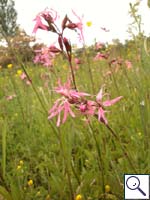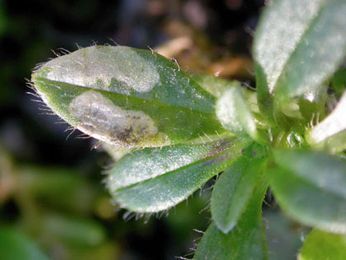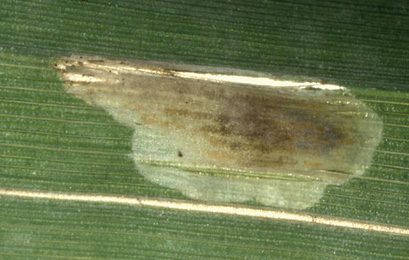|
||||||
|
LYCHNIS. Campions and Catchflys. [Caryophyllaceae] |
|
|
Eight species of Lychnis are recorded in Britain. These include the native Alpine Catchfly (L. alpina), Ragged-Robin (L. flos-cuculi) and Sticky Catchfly (L. viscaria). Lychnis chalcedonica is treated as Silene chalcedonica and Lychnis flos-cuculi is treated as Silene flos-cuculi by Stace (2010). Alpine Catchfly (L. alpina) is protected under Schedule 8 of the Wildlife and Countryside Act, 1981. Ten British miners are recorded on Lychnis. A key to the European miners recorded on Silene including Lychnis is provided in Bladmineerders van Europa. |
 Ragged-Robin Lychnis flos-cuculi |
Key for the identification of the known mines of British |
1a > Leaf-miner and case-bearer: The final case is about 12 mm long and many may be found on a single plant. The white case has distinctive longitudinal stripes. Trivalved tubular silken case of c. 12 mm long. Mouth angle c. 40°. The case is yellowish white, with several characteristic dark length lines. |
 Case of Coleophora galbulipennella on Silene nutans Image: © Jon Clifton (British leafminers) |
|
Coleophora galbulipennella Zeller, 1838 [Lepidoptera: Coleophoridae]. |
1b > Stem-miner or Leaf/Stem-miner |
1c > Leaf-miner |
2a > Stem miner: A shallow external stem-mine (Spencer, 1972b: 29). The mine generally starts as a fine, lower-surface, corridor the seems to end upon a thick vein. In reality the corridor continues by way of the petiole to the stem, where a very long mine is formed in the rind. Frass in widely spaced grains. Pupation within the mine, mostly just above a node; the anterior spiracles penetrate the epidermis. |
|
Ophiomyia melandricaulis Hering, 1943 [Diptera: Agromyzidae]. |
2b > Leaf and Stem-miner: Mine always arising from the leaf base or ending in it, because the larva mines and changes leaves. Mine often broad, irregular corridor like, often touching the midrib. At first corridor often entirely without frass, later in the spring the mines are often less deep, containing thick, irregularly deposited frass lumps. |
|
Delia cardui (Meigen, 1826) [Diptera: Anthomyiidae]. |
2c > Leaf and Stem-miner: Eggs are scattered individually over the leaf upper surface; they are only loosely attached to the plant. The egg shell has a honeycomb structure. The larva begins with first mining one of the top leaves completely out. Next the larva moves down to another leaf, by way of a tunnel made in the stem. In this way several leaves are mined out, completely and full depth. In the attacked part of the plant the stem has become translucent; the damage causes the plant tip to wilt. In the first mines almost no frass is to be found, further down it is deposited in coarse grains. Pupation generally outside the mine (Miles, 1953). |
|
Delia echinata (Seguy, 1923) [Diptera: Anthomyiidae]. |
3a > Leaf-miner: A distinctive mine primarily above mid-rib, with irregular short lateral offshoots into leaf blade. Pupation external (Spencer, 1972: 51 (fig. 172), 55; Spencer, 1976: 270, 271 (fig. 486)). Branched, whitish, upper-surface corridor; main axis overlying the midrib; side branches overlying the main lateral veins. (In Campanula and Phyteuma the mine is much less branched, sometimes nothing more than a corridor on top of the midrib). Frass in rather long strings. Usually the mines begins as a long and narrow, shallow, tortuous lower-surface corridor that ends upon the midrib but otherwise is not associated with the leaf venation. Often this initial corridor is filled with callus, and then even less conspicuous. Pupation outside the mine. A linear mine on the upper surface, usually following the midrib and showing side branches along the veins. The frass is in strings. |
|
Liriomyza strigata (Meigen, 1830) [Diptera: Agromyzidae]. |
3b > Leaf-miner: Irregular mine, locally shallow, elsewhere much deeper, giving it a mottled appearance. In broadleaved plants the mine often begins as a blotch with stellate extensions, but sometimes as a very fine, shallow corridor. In grasses the mine often begins in the leaf sheath. The frass is very fine-grained, initially scattered, later in aggregates. The egg is deposited on the plant surface, and the empty egg shell remains visible. But the larvae are able to leave their mine and restart elsewhere, thus mines without an egg shell can be found as well. The larva also leaves the mine before pupation. Pupation takes place in a newly made, small, blotch mine without frass; this mine may be made in another plant (species). |
|
|
Hydrellia griseola (Fallén, 1813) [Diptera: Ephydridae]. |
3c > Leaf-miner: A white linear-blotch mine, the linear section sometimes not detectable as it becomes enveloped in later blotch (Spencer, 1976: 162-3, figs 296-7). Upper-surface, less often lower-surface, corridor, followed, and often overrun, by a large blotch. Even when the corridor is overun, it usually remains recognisable in the frass pattern. The mine looks whitish in the field. The blotch does not contain much frass, in the form of small black grains, dispersed and stuck to the floor of the mine. Feeding punctures upper-surface (always?). Pupation outside the mine. A common miner, forming a white linear blotch mine (the blotch may obscure the linear portion of the mine) in both native and garden plants.The mine is also illustrated in the Encyclopedia of Life. |
|
Amauromyza flavifrons (Meigen, 1830) [Diptera: Agromyzidae]. |
3d > Leaf-miner: Mine only in the leaf lamina (not the mid-rib). Mine not simultaneously blotch-like (on the upper side or under side) and with very fine frass grains. Mine not touching the midrib. Mine at least in places greenish in transmitted light when seen from either the dorsal side or ventral side. Frass plentiful, irregularly scattered throughout the mine. Pupation always external. The egg shell lies on the leaf surface at the beginning of the mine. |
|
Delia coronariae (Hendel, 1925) [Diptera: Anthomyiidae]. |
3e > Leaf-miner: Upper side blotch mine beginning with a deeper, almost full depth corridor. Frass grains not in thread-like pieces, irregularly scattered. In the large, later blotch indistinct primary and secondary frass lines are found; the frass accumulated in the middle. Each mine begins with one, rarely two, oval egg shells attached to the leaf underside. Sometimes a number of of young mines, and eggs, on one leaf. The first part of the mine is a tortuous corridor, quickly turning into a large blotch. Most of the blotch is full depth, only some patches are upper-surface, and greenish in transparency. According to the literature copious frass in present in dispersed lumps. In my experience the larva -that then looks very dark- may accumulate all frass in its body. The larva is capable of leaving its mine, and starting a new one elsewhere. These secondary mines can be recognised by the large hole that was made by the larva when entering. Pupation outside the mine. A gallery then a blotch, larger and deeper than Amauromyza flavifrons. In large leaves the mine is upper surface and all in one piece. In small leaves the whole leaf may be covered by a full depth mine with the larva mining several leaves in British leafminers. |
|
Pegomya flavifrons (Walker, 1849) [Diptera: Anthomyiidae]. |
|
3f > Leaf-miner: The mine starts as a long, narrow, winding corridor running towards the midrib, widening to a blotch. Usually upper-surface, but in small leaves also full-depth parts may occur. The blotch has broad lobes; in their ends most frass is accumulated in the form of green patches or clouds. Sometimes several larvae share mine. Pupation usually in the soil, less often in the leaf (and then generally not in the mine itself but in a small separated mine, that may even be made in the petiole). |
 Mine of Scaptomyza graminum on Cerastium glomeratum Image: © Jean-Yves Baugnée (Bladmineerders van Europa) |
|
Scaptomyza graminum (Fallén, 1823) [Diptera: Drosophilidae]. |
| Last updated 05-Jul-2019 Brian Pitkin | ||

